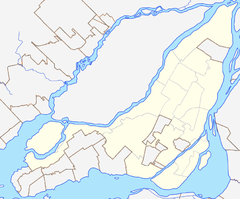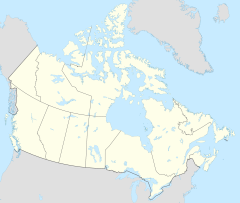Montreal Central Station
Montreal Central Station Gare centrale de Montréal | ||||||||||||||||||||||||||||||||||||||||||||||||||||||||||||||||||||
|---|---|---|---|---|---|---|---|---|---|---|---|---|---|---|---|---|---|---|---|---|---|---|---|---|---|---|---|---|---|---|---|---|---|---|---|---|---|---|---|---|---|---|---|---|---|---|---|---|---|---|---|---|---|---|---|---|---|---|---|---|---|---|---|---|---|---|---|---|
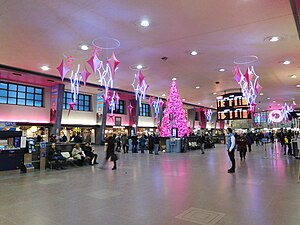 Montreal Central Station, Christmas 2016 | ||||||||||||||||||||||||||||||||||||||||||||||||||||||||||||||||||||
| General information | ||||||||||||||||||||||||||||||||||||||||||||||||||||||||||||||||||||
| Location | 895De la Gauchetière StreetWest Montreal,Quebec | |||||||||||||||||||||||||||||||||||||||||||||||||||||||||||||||||||
| Coordinates | 45°29′59″N73°34′00″W/ 45.4996°N 73.5668°W | |||||||||||||||||||||||||||||||||||||||||||||||||||||||||||||||||||
| Owned by | Cominar REIT (since 2012) Homburg Invest Inc. (2007–2012) CN(1943–2007) | |||||||||||||||||||||||||||||||||||||||||||||||||||||||||||||||||||
| Line(s) | Quebec City–Windsor Corridor | |||||||||||||||||||||||||||||||||||||||||||||||||||||||||||||||||||
| Platforms | 7island platforms(in use) | |||||||||||||||||||||||||||||||||||||||||||||||||||||||||||||||||||
| Tracks | 20 | |||||||||||||||||||||||||||||||||||||||||||||||||||||||||||||||||||
| Bus operators | ||||||||||||||||||||||||||||||||||||||||||||||||||||||||||||||||||||
| Connections | Orange LineatBonaventure | |||||||||||||||||||||||||||||||||||||||||||||||||||||||||||||||||||
| Construction | ||||||||||||||||||||||||||||||||||||||||||||||||||||||||||||||||||||
| Structure type | At-grade | |||||||||||||||||||||||||||||||||||||||||||||||||||||||||||||||||||
| Parking | Yes, paidpark and ride[2] | |||||||||||||||||||||||||||||||||||||||||||||||||||||||||||||||||||
| Bicycle facilities | Bike boxesavailable[2] | |||||||||||||||||||||||||||||||||||||||||||||||||||||||||||||||||||
| Accessible | Yes | |||||||||||||||||||||||||||||||||||||||||||||||||||||||||||||||||||
| Architect | John Schofield; concourse design byJohn Campbell Merrett | |||||||||||||||||||||||||||||||||||||||||||||||||||||||||||||||||||
| Other information | ||||||||||||||||||||||||||||||||||||||||||||||||||||||||||||||||||||
| Station code | Amtrak:MTR
Via Rail:MTRL REM:GCT | |||||||||||||||||||||||||||||||||||||||||||||||||||||||||||||||||||
| IATA code | YMY | |||||||||||||||||||||||||||||||||||||||||||||||||||||||||||||||||||
| Fare zone | ARTM:A[3] | |||||||||||||||||||||||||||||||||||||||||||||||||||||||||||||||||||
| History | ||||||||||||||||||||||||||||||||||||||||||||||||||||||||||||||||||||
| Opened | 1943 | |||||||||||||||||||||||||||||||||||||||||||||||||||||||||||||||||||
| Rebuilt | 1967(Place Bonaventure) | |||||||||||||||||||||||||||||||||||||||||||||||||||||||||||||||||||
| Passengers | ||||||||||||||||||||||||||||||||||||||||||||||||||||||||||||||||||||
| 10,018,800 (AMT 2015)[4] 593,081 (Via 2012)[5] 12,861 (Amtrak FY 2023)[6] | ||||||||||||||||||||||||||||||||||||||||||||||||||||||||||||||||||||
| Services | ||||||||||||||||||||||||||||||||||||||||||||||||||||||||||||||||||||
| ||||||||||||||||||||||||||||||||||||||||||||||||||||||||||||||||||||
| ||||||||||||||||||||||||||||||||||||||||||||||||||||||||||||||||||||
 | ||||||||||||||||||||||||||||||||||||||||||||||||||||||||||||||||||||
| ||||||||||||||||||||||||||||||||||||||||||||||||||||||||||||||||||||
Montreal Central Station(French:Gare centrale de Montréal,IATA:YMY) is the majorinter-city railstationand a majorcommuter railhub inMontreal,Quebec, Canada. Nearly 11 million rail passengers use the station every year,[7]making it thesecond-busiesttrain station in Canada, afterToronto Union Station.
The main concourse occupies almost the entire block bounded byDe la Gauchetière Street,Robert-Bourassa Boulevard,René Lévesque BoulevardandMansfield Streetindowntown Montreal.Its street address and principal vehicular access are on de La Gauchetière; pedestrian access is assured by numerous links through neighbouring buildings. The station is adorned withart decobas-relieffriezeson its interior and exterior.[8]The station building and associated properties are owned by Cominar REIT as of January 2012.[9]Homburg Invest Inc. (renamed Canmarc in September 2011) was the previous owner, since November 30, 2007.[10]Prior to that, from the station's inception in 1943, it had been owned byCanadian National Railway(CN).
Central Station is at the centre of theQuebec City–Windsor Corridor,the busiest inter-city rail service area in the nation (marketed as theCorridor), which extends fromWindsorandSarniain the west, throughToronto,Ottawa,andMontreal,toQuebec Cityin the east. Inter-city trains at Central Station are operated byVia RailandAmtrak,while commuter rail services are operated byRéseau de transport métropolitain(RTM). The station is also a hub for theRéseau express métropolitain,which opened on July 31, 2023. The station is also connected to theMontreal Metrosubway system.
Central Station is the second-busiest Via Rail station in Canada, afterToronto Union Station.Its Via station code is MTRL; its Amtrak code is MTR, and itsIATAcode is YMY.
History[edit]
Central Station opened in 1943, after several years of construction. It stands on the site originally occupied by the terminus of theCanadian Northern Railway's Tunnel Terminal, which had originally opened in 1918.
Canadian National Railways[edit]
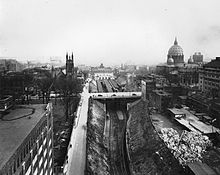
Following the bankruptcy of theGrand Trunk Railway,theGovernment of the Dominion of Canadadecided to consolidate the Grand Trunk Railway with the variousCanadian Government Railwaysto form theCanadian National Railway(CNR). The merger left CNR with a somewhat viable patchwork of different networks.
For much of the first half of the 20th century, CNR found itself in a highly uncomfortable position in Montreal due to the scattering of its terminals.Bonaventure Stationwas used for routes heading west and south east, the Tunnel Terminal served routes heading north, Moreau Street Station served eastbound routes, and theMcGill Street Terminalserved the interurban streetcars of theMontreal and Southern Counties Railway.Making matters worse, the various stations were not connected to one another except via long detours. To transfer a train from Bonaventure Station to Tunnel Station it would need to travel toHawkesbury, Ontario,and to travel from Tunnel Station to Moreau Station it needed to take a detour viaRawdonin theLaurentians.
Consolidation and construction[edit]

The solution chosen was to take advantage of theMount Royal Tunnelto bring trains from the north and east through the tunnel to a large electrified central station. Trains from the south and west gained access by a new elevated viaduct. Interurban electric trains, however, remained at McGill Street Terminal until the service was abandoned in 1956.
The new station plan allowed for the development of air-rights, similar toNew York City's two major stations,Grand Central TerminalandPenn Station.The new Central Station would be situated in the block bounded byDe la Gauchetière Streetto the south,Mansfield Streetto the west, Cathcart Street to the north andUniversity Streetto the east.
Central Station was designed byJohn Schofield,architect-in-chief of CNR. Construction started in 1926, but was halted in 1930 as a result of theGreat Depression.Construction resumed in 1939, the economy having improved. The new station finally opened on July 14, 1943, as the first of a series of large-scale urban redevelopment projects undertaken by CNR and the federal government inDowntown Montreal.But the Central Station that came out was a more modest structure with 20 tracks, 16 of which had platforms.
Opening[edit]

The opening of a 'central' station was part of a consolidation project undertaken by CNR since1929with the enactment of theCanadian National Montreal Terminals Act, 1929byParliament;this saw the closure of former temporary stations operated by CNR predecessorsGrand Trunk(Bonaventure Station) andCanadian Northern.
Consolidation of CN and CP intercity trains[edit]
Central Station was an important passenger station for CN trains from 1943 until the creation ofVia Railin1978.Following Via's full absorption ofCP's passenger trains in1978,intercity rail traffic fromWindsor Stationwas slowly redirected to Central Station. The final Via trains switched from Windsor Station to Central Station were theQuebec Citytrains that operated by way ofTrois-Rivières(April 29, 1984). Amtrak'sAdirondackwas switched to Central Station on January 12, 1986.
Modifications to the station[edit]

At Central Station's opening, tracks (7, 8, 9, 10, 11 and 12) of the Tunnel Station were used only by trains heading north through the tunnel, and they did not continue south of the station. These tracks were finally connected to the south when the old Tunnel Station was demolished as well as the warehouse located south of De la Gauchetière Street and east of Inspector Street (now Mansfield Street). This also allowed for the construction of the new headquarters of CNR as well asPlace Bonaventure.This division is once again in effect following the rebuilding of theDeux-Montagnes line.These tracks are now part of the Two Mountains Subdivision, extending south for a distance of about 1,600 metres (5,249 ft). Undercatenarywires, they serve as parking for trains on the Deux-Montagnes line during the day. Since the reopening of theMont-Saint-Hilaire line,they are also used to park trains from this line.
Tracks 6–16 lead to the tunnel to the north, and lanes 4, 5 and tracks 16 to 23 are in a cul-de-sac to the north (track 16 is provided with a switch just north of the stairs). Tracks 13 to 15 are never used in the northbound direction because of the lack of catenary wires.
One platform (23) is inaccessible to the main concourse, and serves instead as parking for the company cars belonging to upper-level management.
Upon entry into service of theUAC TurboTrain,three tracks (4, 5, 6) were arranged on the west side of the station for a servicing and maintenance facility located there. The workshop, called "Turbo Bay", is still used to maintain lightcommuter trainsas well as the private cars belonging to CN's senior management who use the station. The tracks in the workshop are protected by derails.
Around 1980, the catenary wire was removed from tracks 13, 14, 15 and 16, to allow dome train cars to enter the station.
In 1994–1995, the complete reconstruction of the commuter rail Deux-Montagnes Line resulted in tracks 7–12 being re-electrified at25 kV AC.The original 3000-volt DC catenary was removed from the other tracks.
The platforms of tracks 7 and 8 are now inaccessible from the station, the entrance having been sealed to allow for the development of commercial space, and the tracks now used as parking for trains waiting to be repaired in the "Turbo Bay".
Bombing[edit]
On September 3, 1984, a pipe bomb exploded inside a Central Station locker, killing 3 people and injuring 30 more. The bomb was alleged to have been set by retired American armed forces officerThomas Bernard Brigham,who claimed to have been protestingPope John Paul II's visit to Canada.[11]
Architecture[edit]
With the design being overseen by CNR's architect-in-chief John Schofield (1883–1971),[12]the architecture of Central Station is modern; it is a mixture ofArt Decoand theinternational style.Its large concourse, designed byJohn Campbell Merrett(1909–1998), is illuminated by large windows. Originally, the concourse was cluttered by various ticket counters and kiosks, but, over time, they were pushed to the extremities of the room, which left much more space for the passing crowds.
The 14 underground tracks are accessible by seven stairwells, five of which are equipped withescalators.
The east and west interior walls of the station feature two largebas-reliefsdepicting Canadian life, arts and industry, designed byCharles Comfortand executed by Sebastiano Aiello.[13]Included in the bas relief are a few of the lyrics of "O Canada",which was only an unofficial national anthem when the station was built. The lyrics are in French on the east side of the station and in English on the west side. Canadian artistFritz Brandtnercreated the three large chiselled stone reliefs depictingMercury,ApolloandPoseidonon the station's north exterior wall. The representations of Mercury and Poseidon measure approximately 2.5 by 4.5 m (8 ft 2 in by 14 ft 9 in). Apollo is larger but visual access is very limited. These were obscured by the 1958 construction of the neighbouring Queen Elizabeth Hotel. It is disputed whether Comfort or Brandtner created the thematic stone medallions depicting water, land and air transportation on the station's west, south and east exterior walls. Stylistically, however, the bas-relief medallions bear a strong resemblance to the frieze by Charles Comfort created for theToronto Stock Exchangebuilding in 1937.
Railway operations[edit]

Because of its underground urban location, the railway station quickly imposed operational constraints on CNR.
To avoid smoke in the vicinity of the station, the first trains were powered by electric locomotives. The change of traction took place at Bridge Street, 3 kilometres (1.9 mi) south for trains serving the south-east, atTurcot Yards,6 kilometres (3.7 mi) west for trains serving the west, Val Royal, 14 kilometres (8.7 mi) north for trains running northwest of the junction and 9 kilometres (5.6 mi) north for trains serving the northeast. A fleet of 14 electric locomotives were used for this work.
An elaborate system of signals allowed staff to track the status of the various trains. At the station, as soon as the train was ready to receive passengers, the conductor inserted the key switch in a special switch indicating to staff at the station (ticket checkers) that the train was ready. The movement director at Wellington was also advised via a series of lights that the train was receiving passengers, which then allowed him to establish the route out of the station.
Access to the platforms is controlled by ticket examiners who verify each passenger's ticket. This configuration limits access uniquely to passengers. At the time of departure, after all passengers had descended, the ticket checker would press a button that notified the conductor, through a green light on the platform, that the train could leave. The movement director in Wellington was also advised of the departure by a special light. The final decision of departure was the responsibility of the conductor, until conductors were replaced by a second engineer in the 1990s.
Urban development[edit]
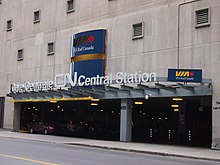
Over the years, the empty space around Central Station has gradually developed to the point where the station building itself is hardly visible from the outside.
In 1948,ICAObuilt its headquarters over the northeast portion of the station along University Street south of Dorchester Street. Then in 1959, theQueen Elizabeth Hotelwas built on the western portion, on the corner of Dorchester and Mansfield, which was the first of many major redevelopments in the area.
In 1960, the former Tunnel Station building was demolished to allow for the construction of the new head-office of CNR, and soon after, a large parking garage was built over the southern part of the station. TheTerminal Towerof 1966 completely hid the station from Dorchester Boulevard.
Belmont Street, east of the station was extended over the station itself to Mansfield Street. On Belmont is the only visible portion of the exterior of the station, the rest having been attached to the various buildings built over the years.
The north side of Dorchester (now René Lévesque Boulevard) then saw the construction of the complex ofPlace Ville-Marie,which now includes four skyscrapers whose highest was 45 floors and an underground shopping mall, which was the beginning of theUnderground City.
In the mid 1960s,Place Bonaventurewas built over the tracks, south of de La Gauchetière Street. In 1966, Central Station and Place Bonaventure were connected underground by the newBonaventure metro station,named in honour of the demolished Bonaventure railway station.
All of these buildings underwent major renovations over the next 30 years.
Connecting facilities[edit]

Central Station is located adjacent toCNHeadquarters and is an important link in theunderground city,with tunnels toPlace Ville-Marie,Place Bonaventure,theQueen Elizabeth Hotel,1000 de La Gauchetière,and theBonaventure metro station.
It also contains twoparking facilities,one of which is a multi-level facility that is located above the station.
Les Halles de la Gare[edit]
Central Station has gradually grown to includeLes Halles de la Gare,a shopping andrestaurant complex.Real estate pressures have meant that the shopping area would be expanded several times.
While the old ICAO building was undergoing renovations in 1981, (after the relocation of ICAO toSherbrooke Street), a railway-themed shopping area expanded on the north side of the station. This section was completely destroyed in 1995 during the restoration of the Deux-Montagnes Line, and was replaced by the present Les Halles de la Gare complex.
U.S. preclearance[edit]
In May 2012, U.S. SenatorsCharles Schumer,Kirsten Gillibrand,Patrick Leahy,andBernie Sanderssent a letter to PresidentBarack Obamaurging him to fastrack the approval of aU.S. Customspreclearancefacility at the station that will benefit U.S. bound travelers on theAdirondackfrom having to stop at therailway stationlocated inRouses Point,New Yorkfor immigration and customs checks whenever they cross theCanada–US border.Under the arrangement, the stop inSaint-Lambertwould be removed.[14]The agreement will also allow another Amtrak line, theVermonter,to be extended from its current terminus atSt. Albansto Montreal, though this agreement must first be approved byUnited States Congressand theParliament of Canada.[15][16]This would enable direct travel by train from Montreal toWashington, D.C.'sUnion StationviaMassachusettsand New York City, as well as the potential development of direct service toBoston.[17]
On March 16, 2015, the United States and Canada signed an agreement that would allow for such a facility.[15][16]Enabling legislation was enacted by the United States on December 16, 2016 as the Promoting Travel, Commerce, and National Security Act of 2016.[18]
Services[edit]

Via Rail[edit]
FrequentCorridorservices offer multiple-daily departures on the following routes:
- Fallowfield/Ottawa-MontrealtoAlexandriaandOttawa
- Montreal-Quebec CitytoSaint-Lambert,Drummondville,Sainte-FoyandQuebec City
- Toronto-MontrealtoCornwall,Brockville,Kingston,Belleville,OshawaandToronto,with westbound trains continuing toOakvilleandBurlington
In addition, the following long distance/rural services are operated several times weekly:
- Montreal–Senneterre traintoShawinigan,La TuqueandSenneterre
- Montreal–Gaspé trainto Charny,Rivière-du-Loup,Rimouski,Matapedia,Carleton-sur-Mer,New Carlisle,Chandler,PercéandGaspé(Note: This service was suspended by Via Rail from August 22, 2013 due to infrastructure problems between Matapedia and Gaspé)[19]
- OceantoSaint-Lambert,Sainte-Foy,Rivière-du-Loup,Rimouski,Matapedia,Campbellton,Bathurst,Miramichi,MonctonandHalifax(Note: This service was suspended by Via Rail from March 13, 2020 due to theCOVID-19 pandemic.)[20]
- Montreal–Jonquière traintoShawinigan,Chambord,andJonquière
Amtrak[edit]
- AdirondacktoSaint-Lambert,Plattsburgh,Saratoga Springs,Schenectady,Albany–Rensselaer station,Poughkeepsie,and New York City, as well as intermediate points.
Exo[edit]
- Mont-Saint-Hilaire line(Exo 3)
- Mascouche line(Exo 5)
Réseau express métropolitain[edit]

A separaterailway platformhas been built to the south of the existing platforms for the REM service which connects the South Shore to the Trudeau Airport, West Island and North Shore. Service to the South Shore began 31 July 2023,[21]the other destinations are delayed until late 2024.
Public transit connections[edit]
Metro[edit]
- Bonaventure(Orange Line)[22][23]
- McGill(Green Line) is three blocks north, by way of theUnderground city,which includes passing throughPlace Ville Marieand theMontreal Eaton Centre
STM buses[edit]
SeeBonaventure Metrofor connecting bus routes.[1]
Other connecting buses[edit]
References[edit]
- ^abc"AMT - Deux-Montagnes line - Bus transfers".Archived fromthe originalon September 27, 2016.
- ^ab"Montréal Central Station train station".Via Rail.Archivedfrom the original on 2016-10-07.
- ^"Fare Zones".Metropolitan Regional Transportation Authority.1 July 2022.Retrieved1 July2022.
- ^AMT Rapport Annuel 2015 - Transformer la mobilité(PDF).Agence métropolitaine de transport (AMT). p. 10.ISBN978-2-550-75552-4.Archived(PDF)from the original on 16 October 2016.Retrieved26 September2016.
- ^"Base de données 2011 - Attraits/Attractions".Tourisme Montréal. Archived fromthe originalon 31 December 2013.Retrieved24 May2013.
- ^"Montreal, QC (MTR)".Great American Stations. 2023.Retrieved25 January2024.
- ^Based on combined ridership of Via Rail, Amtrak, and AMT (see infobox on top of article).
- ^"Art Deco Montreal, Tour of Central Station".artdecomontreal.Archived fromthe originalon 2008-07-03.
- ^Marowits, Ross (16 January 2012)."Cominar reaches friendly deal with Canmarc with $904.4-million offer".Canadian Press.Archivedfrom the original on 12 January 2016.Retrieved13 July2015.
- ^"Homburg Canada".homburgcanada.Archived fromthe originalon 2008-09-15.Retrieved2008-09-12.
- ^Curran, Peggy; Collister, Eddie (4 September 1984)."War vet held in bombing".Montreal Gazette.Retrieved12 April2016– viaGoogle News Archive.
- ^"Canadian National Railways Central Station".Canada's Historic Places.Archivedfrom the original on 12 January 2016.Retrieved13 July2015.
- ^"Canadian National Railways Central Station".Canada's Historic Places.Parks Canada.Archivedfrom the original on August 5, 2023.
- ^Bowen, Douglas John (2012-05-11)."Customs relief in sight for Amtrak's Adirondack".RailwayAge.Archivedfrom the original on 17 June 2012.Retrieved22 June2012.
- ^abBowen, Douglas John (March 16, 2015)."Pact bodes well for restored Amtrak Montrealer".Railway Age.Archivedfrom the original on August 9, 2015.
- ^ab"United States and Canada Sign Preclearance Agreement"(Press release). Washington: Department of Homeland Security. March 16, 2015.Archivedfrom the original on April 17, 2016.
- ^"Northern New England Intercity Rail Initiative".Massachusetts Department of Transportation.Archivedfrom the original on 2015-01-20.
- ^Pub. L.114–316 (text)(PDF),H.R. 6431,130Stat.1593,enactedDecember 16, 2016
- ^"Montréal–Gaspé train – Overview".viarail.ca.Archivedfrom the original on 2016-07-03.
- ^Via Rail(March 13, 2020)."Via Rail suspends the Canadian and Ocean routes because of COVID-19".Newswire.RetrievedSeptember 8,2020.
- ^"Commissioning of the REM".rem.info.July 7, 2023.
- ^"AMT - Deux-Montagnes line - Metro transfers".Archived fromthe originalon September 27, 2016.
- ^"Bonaventure Station".
Further reading[edit]
- Schofield, John (November 1943)."Canadian National Railways–Montreal Terminal Development"(PDF).20(11): 185–197.
{{cite journal}}:Cite journal requires|journal=(help)
External links[edit]
- Montreal Central Station – Amtrak
- Montreal Central Station – Station history at Great American Stations (Amtrak)
- Exo commuter rail stations
- Via Rail stations in Quebec
- Railway stations in Montreal
- Railway stations in Canada opened in 1943
- Amtrak stations in Canada
- Art Deco architecture in Canada
- Art Deco railway stations
- Union stations in Canada
- Downtown Montreal
- 1943 establishments in Quebec
- Réseau express métropolitain railway stations

